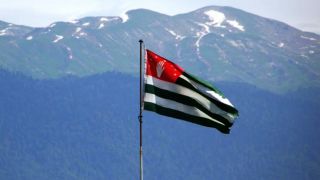Now that the U.S. Democrats have lost the presidential race, their “hawks” are foretelling Russia’s inevitable rise in the post-Soviet area and, particularly, Central Asia. Their argument is that the Russians may well achieve peaceful settlement in Syria now that ISIL is being forced from that country – something that runs counter to the Americans’ expansionist policy in the region.
Their “vital interest” there is to make the war in Syria even harder and to use it as a pretext for setting the Russians and the Turks by the ears. Experts wonder why. One of the possible answers is to distract the former from other strategic spots in Eurasia, first of all, from Central Asia.
This is exactly why Stratfor is so persistent in claiming that Russia’s high diplomatic activity in Syria is part of its plan to get a military-strategic grip on its CIS and CSTO partners.
The experts serving the U.S. rulers and militaries cannot afford admitting that the key reason why the Russians are intensifying security contacts with their Eurasian neighbors is that they wish to protect the post-Soviet area from international terrorism. Unlike the Americans, the Russians do not apply double standards in this field and are showing consistency in both Syria and Central Asia.
Today, Afghanistan - a country that due to the Americans’ “support” has turned into the world’s drugs production and terrorists training center – constitutes a big danger for its neighbors. Along with its own Taliban, Afghanistan is home to ISIL and dozens of other radical Islamic groups, like the Uzbek Islamic Movement of Uzbekistan, the Uygur Khilafat Movement, the Kazakh Fatha, the Kyrgyz Kyrgyzstan Kalkany, the Islamic Party of Turkestan. All of them are involved in the dangerous plans to clear Afghanistan, Pakistan and Central Asia from the “unfaithful” and to create an Islamic State of Khorasan in the region.
Here Tajikistan is playing the role of a buffer between unstable extremist-ridden Afghanistan and the southern border of the CIS. Central Asia is a zone of special strategic interest for Russia, who due to geographic, political and economic factors, is responsible for peace and stability in that country. And today this interest coincides with Central Asia’s wish to be secure and social and economically stable.
We know why Russia and Tajikistan are so active in their defense cooperation and why they are going to deploy Uragan multiple artillery rocket systems in Dushanbe and Qurghonteppa. They are just protecting themselves from the terrorists moving from Syria and Afghanistan to the CIS southern borders. But Stratfor analysts are ringing the alarm bell about this.
Unbiased military experts see this as a way for the Russians to make their base in Tajikistan stronger and better prepared to rebuff possible terrorist attacks, while the western press is concerned about Russian Defense Minister Sergey Shoygu’s most recent statement about the plans to deploy more modern weaponry in Tajikistan. But without this weaponry, the Tajiks will not be able to protect their country if terrorists decide to attack them, will they?
The Russian 201st base is really vital for them. This base is one of the CIS’s key outposts in Central Asia, a guarantor of peace and stability in that region. Besides, in Tajikistan the Russians have Okno, a space surveillance station allowing them to detect any space objects of dual purpose even if they are very small and fly as high as 40,000 meters. This facility is crucial for the security of the region.
According to Tajik President Emomali Rahmon, in 2015-2016, the Tajiks built over 80 modern outposts on their border with Afghanistan and are building 100 more. But if acting alone, they will hardly be able to guarantee absolute safety from extremists and drug smugglers.
So, we see nothing strange in their wish to cooperate with the Russians in defense. Last Sept they hosted joint anti-terror maneuvers at their Lyaur training ground. The event involved almost 800 soldiers and over 200 weapons. The objective was to effectively detect and rebuff illegal armed groups in highlands.
Western experts were concerned about the last year’s Russian-Tajik maneuvers - an event that involved over 10,000 soldiers and officers and over 1,500 weapons from both countries – and especially about the use of Russian planes.
But even they are forced to admit that this partnership is transparent and clear and its goals are urgent and justified. This benefits not only Tajikistan but also its neighbors. Besides, this partnership has a legal framework and complies with the goals of the Collective Security Treaty Organization.
This partnership has only one good goal – to guarantee peace and security in Central Asia – and will certainly be continued even though it strongly concerns the U.S. hawks.
Viktor Barsov, specially for EADaily
 Trump and Zelensky held a short meeting in Rome
Trump and Zelensky held a short meeting in Rome The Supreme Court allowed Russians to defend themselves with a knife under certain conditions
The Supreme Court allowed Russians to defend themselves with a knife under certain conditions Trump commented on Witkoff's meeting with Putin
Trump commented on Witkoff's meeting with Putin There are no paths to power left: Zelensky is being prepared to leave the political scene — MP
There are no paths to power left: Zelensky is being prepared to leave the political scene — MP Zelensky "agreed" with Trump: Crimea cannot be won back ... but there are sanctions
Zelensky "agreed" with Trump: Crimea cannot be won back ... but there are sanctions Zelensky's government wants to extradite entrepreneurs from the EU. And rip it off like a stick
Zelensky's government wants to extradite entrepreneurs from the EU. And rip it off like a stick The world's largest Norwegian state Welfare Fund is suffering significant losses
The world's largest Norwegian state Welfare Fund is suffering significant losses